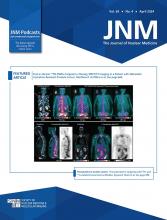Article Figures & Data
Tables
- TABLE 1.
Summary of Prospective Trials of MDT for Oligorecurrent Hormone-Sensitive Prostate Cancer
Trial Design Imaging Patients (n) Lesion distribution Median follow-up Result STOMP (18) Phase II RCT MDT vs. surveillance (80% MDT was SBRT) Choline PET/CT (1–3 lesions) 62 Bone, 39%; node, 55%; viscera, 2% 36 PFS, 10 vs. 6 mo; ADT-FS, 21 vs. 13 mo ORIOLE (19) Phase II RCT SBRT vs. surveillance Conventional imaging (1–3 lesions) 54 Bone, 39%; node, 61% 19 6-mo progression rate: 19% vs. 61% POPSTAR (20) Phase I SBRT (33% had ADT) NaF PET/CT (1–3 lesions) 33 Bone, 61%; node, 36%; bone and node, 3% 24 2-y distant PFS, 58%; 2-y ADT-FS, 48% MRgRT (23) Phase II single MDT (73% SBRT) Negative conventional and positive PSMA PET/MRI/CT (1–5 lesions) 37 Node, 92%; bone, 8% 16 22% had complete response with PSA < 0.05; ADT-FS, 17.7 mo RCT = randomized controlled trial; ADT-FS = ADT-free survival.
- TABLE 2.
Summary of Selected Phase II–III Randomized Trials of 223Ra and 177Lu-Based RLTs in Prostate Cancer
Trial Design Dosage Inclusion criteria Patients (n) Result ALSYMPCA (44) Phase III RCT; standard of care + 6 doses of 223Ra vs. standard of care 50 kBq per kilogram of body weight every 4 wk Progressive mCRPC and ≥2 symptomatic bone metastases with no known visceral metastases 921 OS, 14.9 vs. 11.3 mo; time to first symptomatic skeletal event, 15.6 vs. 9.8 mo; meaningful improvements in pain (30.2% vs. 20.1%) VISION (51) Phase III RCT; 4–6 cycles of 177Lu-PSMA-617 vs. standard of care 7.4 GBq every 6 wk Progressive mCRPC ≥1 PSMA-positive lesion with uptake greater than liver parenchyma and no PSMA-negative lesions 831 Improved OS, median 15.3 mo vs. 11.3 mo; radiographic PFS, median 8.7 vs. 3.4 mo; time to first symptomatic skeletal event or death, median of 11.5 vs. 6.8 mo TheraP (53) Phase II RCT; op to 6 cycles of 177Lu-PSMA-617 vs. cabazitaxel 8.5 GBq for first cycle, with 0.5-GBq decrease per subsequent cycle (6 wk between cycles) Progressive mCRPC ≥1 PSMA-positive lesion with SUVmax ≤20 (with all other PSMA-avid sites having SUVmax of ≥10) and nondiscordant findings between PSMA and 18F-FDG PET/CT 200 PSA response rate (50% reduction or more), 66% vs. 37%; progression was delayed with 177Lu-PSMA-617 (HR, 0.63) RCT = randomized controlled trial.
- TABLE 3.
Summary of Prospective Studies Integrating RLT with External-Beam Radiotherapy in Oligorecurrent Disease
Trial Inclusion n RLT and dosage Timing of RLT Primary endpoint Randomized evaluating addition of RLT to SBRT LUNAR (NCT05496959) ≤5 lesions outside prostate/prostate bed on PSMA PET/CT 90 177Lu-PNT2002 (6.8 GBq per cycle, 2 cycles given 6–8 wk apart) Neoadjuvant PFS: progression defined on basis of PSMA PET/CT scans obtained at 12 mo or at time of PSA-based biochemical progression; initiation of salvage therapy POPSTAR II (NCT05560659) ≤5 sites of nodal or bony metastases, with at least 1 site with SUVmax 2× SUVmax liver 92 177Lu-PNT2002 (6 GBq (±10%) per cycle, 2 cycles 6–8 wk apart) SABR between cycles 1 and 2 PFS: progression defined as biochemical or clinical RAVENS (NCT04037358) ≤3 metastases with at least 1 bone (on CT or bone scan) or ≤5 metastases with at 1 least 1 bone (on PET/CT); PSADT < 15 mo; PSA ≥ 0.5 64 223Ra (55 kBq per cycle, 6 cycles 4 wk apart) SABR concurrent with cycle 1 PFS: progression defined as biochemical (PSA increased by ≥2 ng/mL from nadir) or clinical (based on conventional imaging or initiation of ADT) PSMA-DC (NCT05939414) ≤5 metastases by PSMA PET only with none on CT or bone scan 450 177Lu-PSMA-617 (6.8 GBq per cycle, 4 cycles given 6 wk apart) Neoadjuvant Metastasis-free survival: defined as lack of metastasis identifiable on bone scan, CT, or MRI Phase II single arm evaluating adding radiotherapy to RLT ProstACT target (NCT05146973) Recurrent after prostatectomy; ≤5 nodal lesions, all at or below aortic bifurcation with SUVmax > 5; radiotherapy here is conventionally fractionated salvage radiotherapy 50 177Lu-DOTA-TLX591-CHO (2.8 GBq per cycle, 2 cycles given 2 wk apart) Adjuvant PSA-based PFS: time from enrollment to time of PSA increase > 25% NCT03361735 ≤4 metastases with at least 1 bone lesion and ≤1 visceral or nodal lesions 24 223Ra 5 (55 kBq per cycle, 6 cycles 4 wk apart) 9 mo of ADT, with SBRT starting on day 1 of ADT and radium starting on day 31 of ADT Time to treatment failure: time from initiation of ADT for metastatic disease until PSA increase to >pre-ADT level or PSA > 10 (whichever is smaller) or radiographic or clinical progression or resumption of ADT by physician’s choice PSADT = PSA doubling time; RCT = randomized controlled trial.







